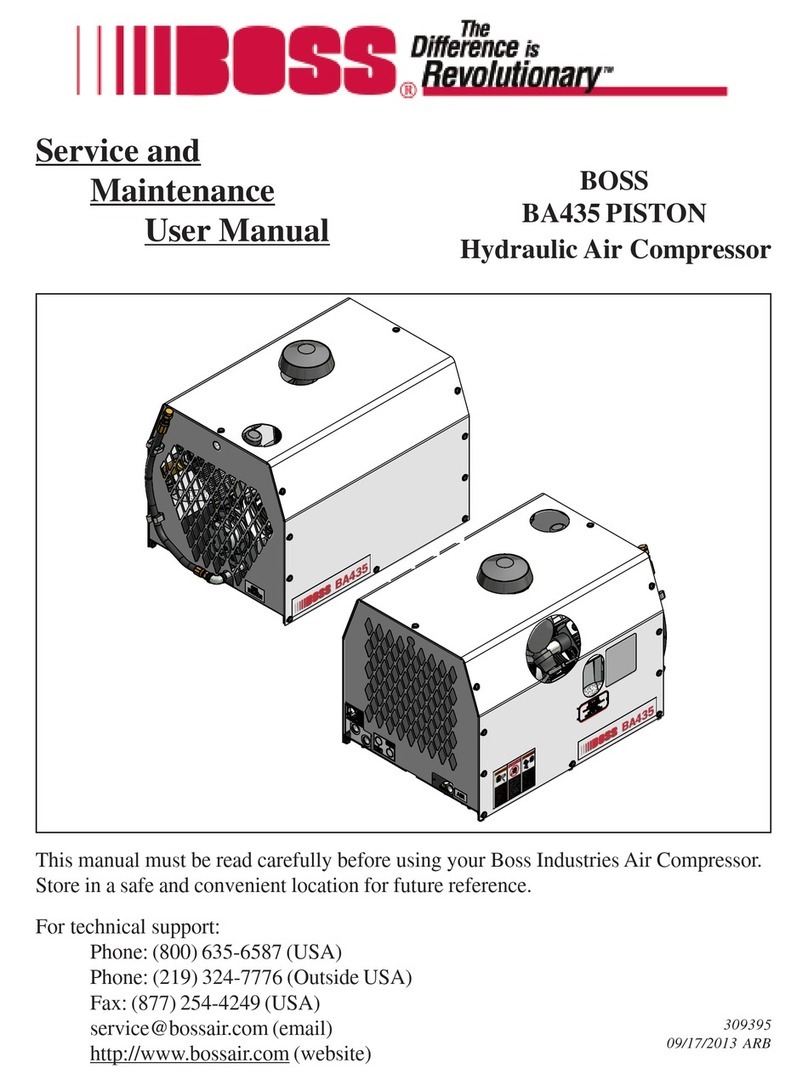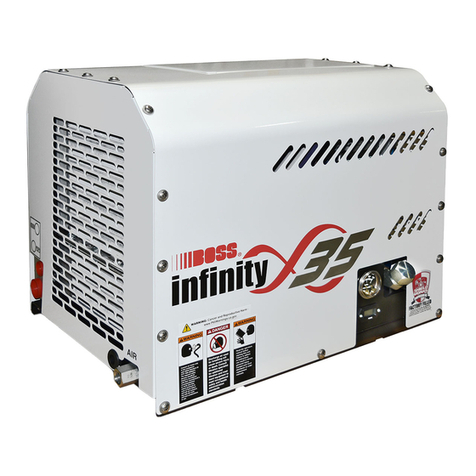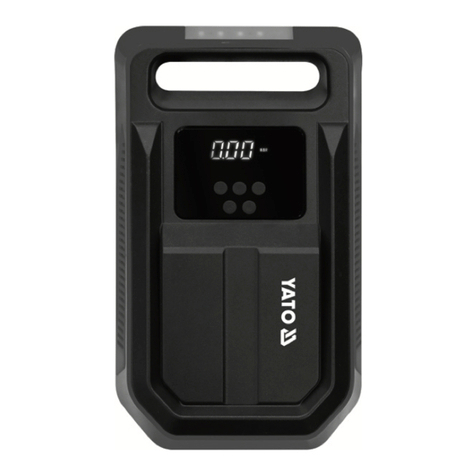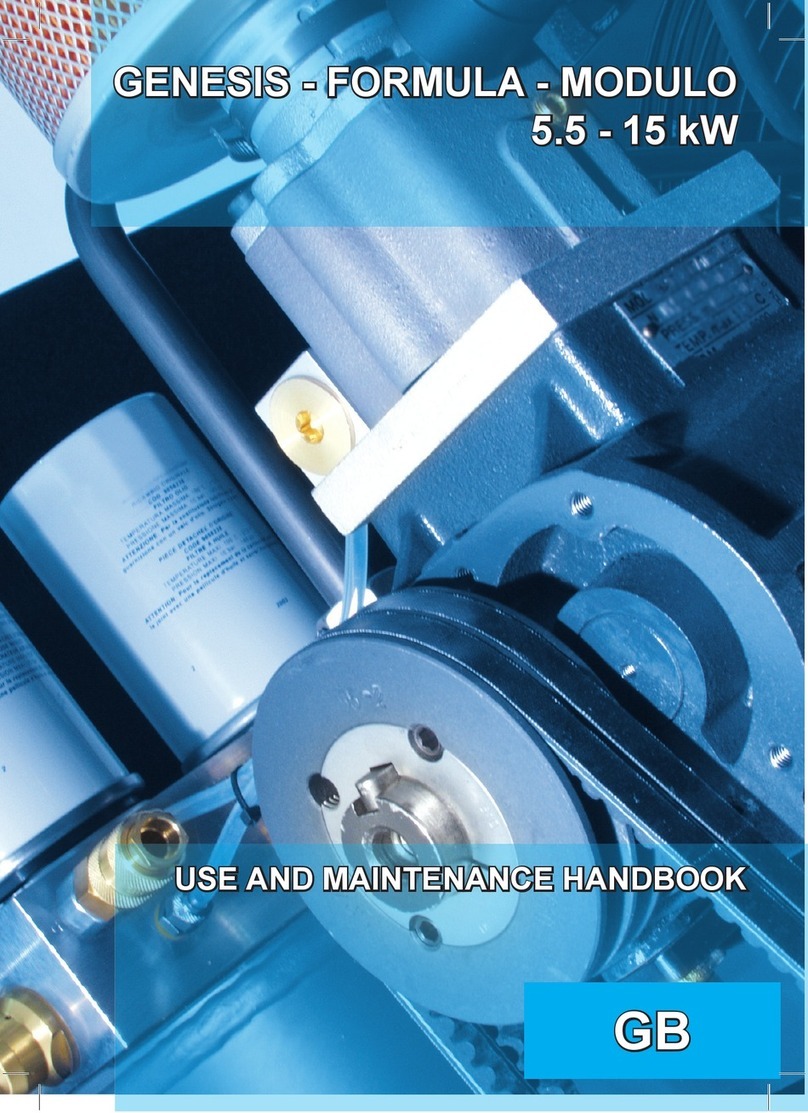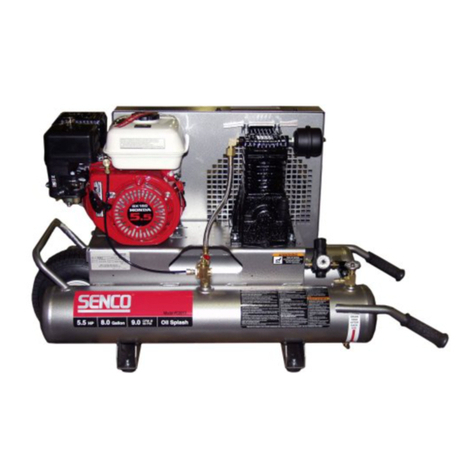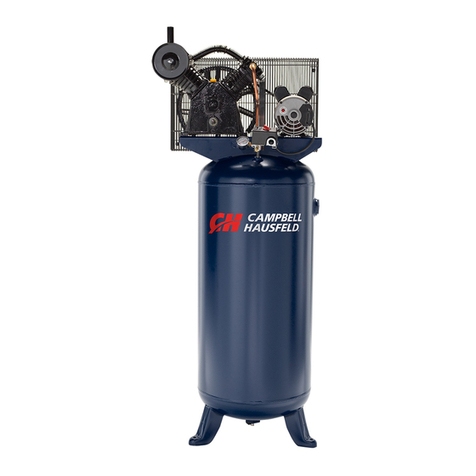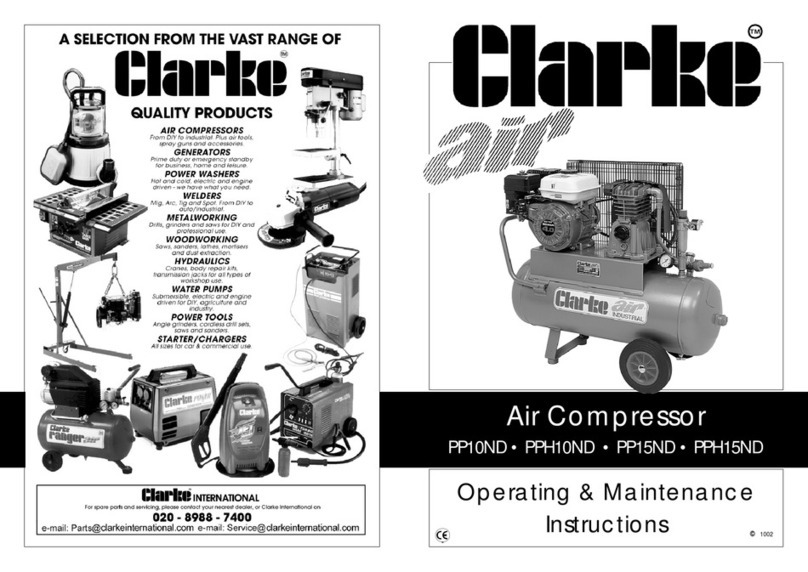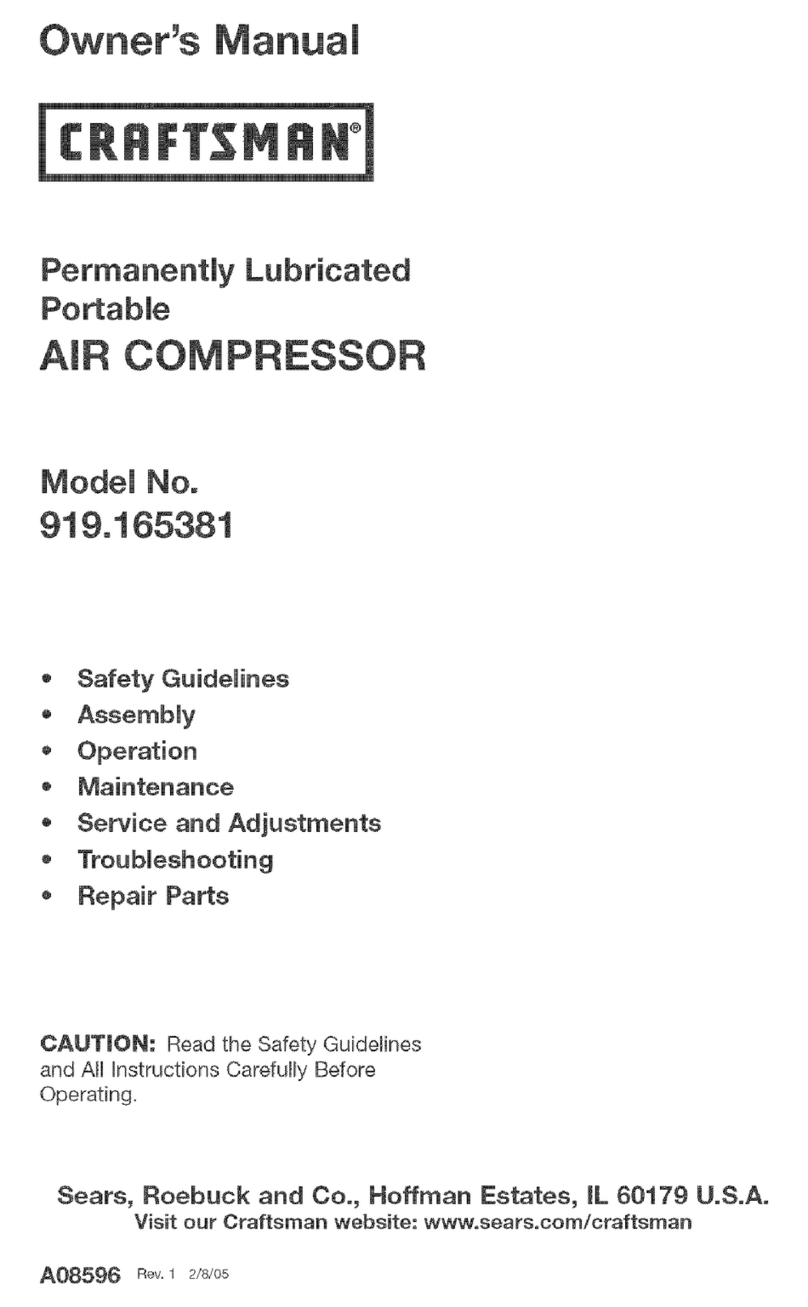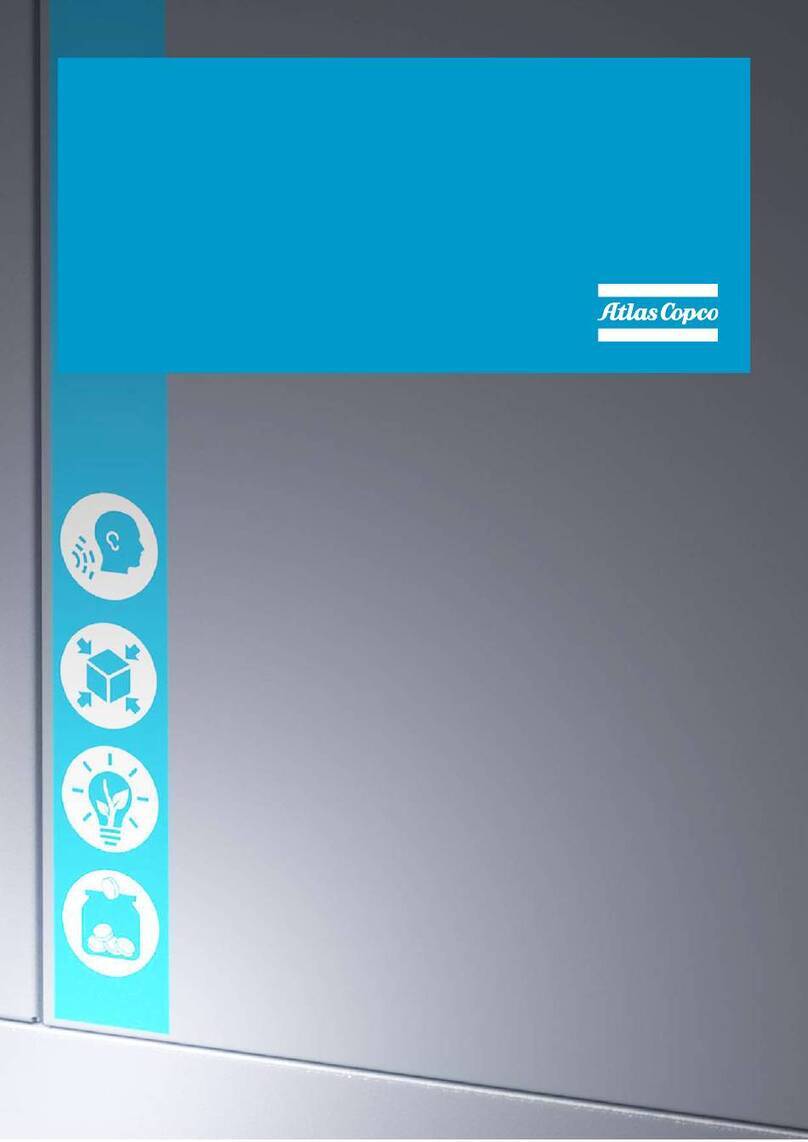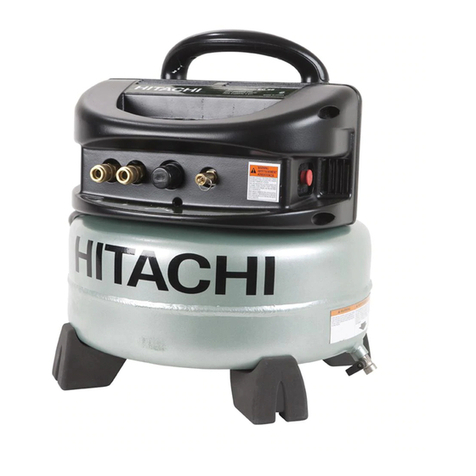Boss Industries Bullet 2 Installation and user guide

This manual must be read carefully before using your Boss Industries Inc. Air Com-
pressor. Store in a safe and convenient location for future reference.
309003
01/09/2012 DCL
Service and
Maintenance
User Manual Engine Driven
Air Compressor
For technical support:
Phone: (800) 635-6587 (USA)
Phone: (219) 324-7776 (Outside USA)
Fax: (877) 254-4249 (USA)
Email: service@bossair.com
Website: http://www.bossair.com

2309003

3309003
Contents
Manual Change History................................................................................................5
1.1 Revision List....................................................................................................5
Welcome........................................................................................................................6
2.1 General Information..........................................................................................6
2.2 Overview .........................................................................................................6
Safety...................................................................................................................7-9
3.1 General Safety Overview..................................................................................7
3.2 Safety Precautions...................................................................................8-9
Specifications..............................................................................................................10
4.1 Specification Sheet........................................................................................10
Description of Components..............................................................................11-12
5.1 Engine............................................................................................................11
5.2 Drive System...............................................................................................11
5.3 Compressor Airend.......................................................................................11
5.4 Separator System......................................................................................11
I. Sump Tank.............................................................................................11
II. Coalescer Element.................................................................................11
5.5 Pressure Relief Valve.....................................................................................12
5.6 Fuel Tank......................................................................................................12
5.7 Carbon Canister............................................................................................12
5.8 Compressor Air Filter..................................................................................12
5.9 Compressor Oil Filter.................................................................................12
5.10 Compressor Oil Cooler.......................................................................12
Installation & Operation...................................................................................13-16
6.1 System Installation Overview........................................................................13
6.2 Lifting................................................................................................13
6.3 Mounting the Compressor..........................................................................14
6.4 Pre-Start-up Inspection............................................................................14
6.5 Check Fluid Levels.......................................................................................14
6.6 Machine Documentaion.............................................................................15
6.7 Operating Procedure......................................................................................15
6.8 Shutdown Procedure...................................................................................15
6.9 Operating Conditions...................................................................................16
Maintenance........................................................................................17-20
7.1 Overview.............................................................................................17
7.2 Recommended Spare Parts List............................................................17
7.3 How to Order Parts............................................................................17
7.4 Maintenance Chart.............................................................................18

4309003
7.5 Compressor Oil..................................................................................19
7.6 Compressor Oil Fill, Level, and Drain...............................................................20
7.7 Air Intake Filter.......................................................................................20
7.8 Belt Tensioning Procedure.....................................................................21
7.9 Belt Replacement Procedure........................................................................21
Troubleshooting......................................................................................22-25
8.1 Overview............................................................................................22
8.2 Machine Will Not Start.............................................................................22
8.3 Unplanned Shutdown..........................................................................23
8.4 Improper Shutdown Pressure................................................................23
8.5 Blowdown Valve................................................................................24
8.6 Engine Overheating..............................................................................24
8.7 Oil Consumption.................................................................................24
8.8 Coalescer Plugging..............................................................................25
8.9 High Compressor Discharge Temperature..............................................25
8.10 Contacting Boss Industries Inc......................................................................25
Warranty.....................................................................................................26-31
9.1 Warranty Statement............................................................................27
9.2 Summary of Main Warranty Provisions.................................................28
9.3 Return Goods Instructions.................................................................29
9.4 Preparation of Part Return.................................................................29
9.5 Filing Procedures..............................................................................29
9.6 Claims provisions.................................................................................30
9.7 Damage in Transit..............................................................................30
9.8 Airend Exchange Program...................................................................31
Drawings.....................................................................................................33-49
10.1 Frame System...............................................................................34
10.2 Engine System.....................................................................................36
10.3 Compressor System.............................................................................38
10.4 Cooler System...............................................................................40
10.5 Sump Tank System.....................................................................42
10.6 Canopy System...............................................................................44
10.7 Coalescer System..............................................................................46
10.8 Wiring Diagram...............................................................................48
10.9 System Schematic...............................................................................49

5309003
Revision List
ETAD NOITACOL EGNAHCFONOITPIRPCSED SLAITINI
1102/82/7 71.gP .tsiLstraPerapSdetadpU MCM
1102/82/7 54-44.gP .metsySyponaCdetadpU MCM
2102/02/4 01.gP .edutitlahgihrofsnoitacificepsenigneIFEdeddA MSB
1.1 Revision List

6309003
Welcome
2.1 General Information
Thank you for choosing the Boss Industries Inc. Bullet 2Air Compressor.
Before operating this compressor, read over this manual and become well
acquainted with your new machine. Doing this will increase your safety and
maximize the life of the machine.
While this manual is written to be as accurate as possible, Boss Industries
Inc. strives to continually improve the efficiency and performance of its
machines. As a result, sometimes there may be slight differences between a
given version of the manual and the machine.
2.2 Overview
The Boss Industries Inc. Bullet 2 is a compact, strategically designed system. It integrates all major
components on a single frame, which is enclosed in a tough, weather-resistant canopy.
The Bullet 2 design provides output of up to 70
CFM (cubic feet of air per minute) at up to a
maximum of 100 PSI (pounds per square inch).
Two maintenance doors make virtually all
components accessible for maintenance and
service. Instrumentation clearly displays pressure
and hours of operation. Other features, including a
spin-on compressor oil filter, and a spin-on
coalescer element, reduce the time and costs
associated with routine maintenance.
The Bullet 2 also has enhanced safety features to
protect your valuable resources: minimum pressure
orifice, high compressor oil temperature shutdown,
automatic blowdown device, pressure relief valve,
low engine oil pressure shutdown, and clearly
displayed warning/information decals.
This manual must be read carefully before using your Boss Industries Inc. Air Com-
pressor. Store in a safe and convenient location for future reference.
309003
04/7/2011 DCL
Service and
Maintenance
User Manual Engine Driven
Air Compressor
For technical support:
Phone: (800) 635-6587 (USA)
Phone: (219) 324-7776 (Outside USA)
Fax: (877) 254-4249 (USA)
Email: service@bossair.com
Website: http://www.bossair.com

7309003
IMPORTANT: READ BEFORE OPERATING EQUIPMENT
Remember, safety is basically common sense. While there are standard safety rules, each situation has its
own peculiarities that cannot always be covered by rules. Therefore with your experience and common
sense, you are in a position to ensure your, and others, safety. Lack of attention to safety can result in:
accidents, personal injury, reduction in efficiency and worst of all – Loss of Life. Watch for safety hazards
and correct them promptly.
Understanding the proper operation of this equipment is critical to its safe operation. The owner, lessor or
operator of this equipment is hereby notified and forewarned that any failure to observe the safety and
operating guidelines may result in injury and/or damage. Boss Industries Inc. expressly disclaims responsi-
bility or liability for any injury or damage caused by failure to observe these specified precautions or by
failure to exercise the ordinary caution and due care required while operating or handling this equipment,
even though not expressly specified.
In addition to following these safety guidelines, the operator should follow any company specific guidelines
and procedures. Consult your immediate supervisor for specific company safety guidelines and/or proce-
dures.
The following safety symbols are used throughout the manual to draw attention to important information. If
the information is not carefully read and the instructions are not followed, severe injury, death, and/or
damage to property and equipment may occur.
Indicate[s] an imminently hazardous situation, which, if
not avoided, will result in death or serious injury.
Indicate[s] a potentially hazardous situation, which, if not
avoided, could result in death or serious injury.
Indicate[s] a potentially hazardous situation, which, if not
avoided, could result in minor or moderate injury.
Indicate[s] a potentially unsafe situation or practice,
which, if not avoided can result in property and/or
equipment damage only.
Safety
2.1 General Safety Overview

8309003
Safety
The following safety precautions are a general guide to safe operation of the equipment.
Read and understand the operations manual and all other safety
instructions before using this equipment. Failure to follow
operating instructions and/or failure to follow maintenance proce-
dures and intervals could result in personal injury, death, and/or
damage to equipment and property.
Pressurized System. Do not attempt to remove any compressor
parts without first completely relieving entire system of pressure.
Do not attempt to service any part of the equipment while in
operation. Never attempt to repair or modify any pressure vessel
or device.
System contains hot oil. The compressor system must be shut off
prior to servicing. Open the service valve to ensure complete relief
of system air pressure and stored energy. Then permit system to
cool down prior to adding compressor oil or servicing the unit.
Do not use air from this compressor for breathing or food process-
ing. Air from this compressor will cause severe injury if used for
breathing or food processing.
The compressor is designed to compress air only. Do not attempt
to compress other gases. Compression of other gases may create
a situation where an explosion or fire may occur.
Do not use flammable solvents for cleaning compressor parts as
this can cause the unit to ignite or explode during operation. Keep
combustibles out of and away from compressor inlet, and any
associated enclosures.
2.1 Safety Precautions

9309003
Safety
Never disable, override, or remove safeties, either temporarily or permanently.
Do not modify pressure switches to operate equipment at a higher pressure
than specified. When using a hose reel, the complete system must be designed
with safety valves in accordance with OSHA Regulation 1910.169.
Never leave the machine running unattended or leave a tool connected to an
air hose when not using. Relieve system of all stored air pressure after use.
Never adjust the pressure switch to a setting of greater than 150 PSI. Oper-
ating the compressor at greater than 150 PSI may result in personal injury and
property damage.
Mount the compressor in a stable location capable of supporting 500 lbs.
Slight vibration may occur during operation and the machine may move if not
securely mounted.
When using tools, maintain secure footing at all times. Do not overreach or
awkwardly use air tools.
Use only Boss Industries Inc. approved replacement parts or equivalent.
2.1 Safety Precautions (continued)
Over-tensioning belts will cause premature belt, bearing, and shaft seal
failure.

10 309003
Specifications
4.1 Specification Sheet
snoitacificepSrosserpmoC snoitacificepSenignE
ledoM 2telluB epyT
niwT-VelcyC-4urabuS
delooCriAVHO
enilosaG
epyT yratoRdedoolFliO
wercS ledoM 27HE
)MFC(yrevileD GISP001@MFC07 rewoP MPR0063@PH52
egnaRerusserPgnitarepO GISP511-08 tnemecalpsiD sehcnicibuc8.93
gnitarepOtneibmA
egnaRerutarepmeT F°001ot°02- ekortS&eroB ni65.2xni51.3
yticapaCpmuSliO snollaG2 yticapaCliO strauQ7.1
yticapaCmetsySlatoT snollaG5.2 yrettaB F°23@ACC024-V21
noitcennoCecivreSriA TPN"4/3 yticapaCknaTleuF snollaG5
metsySgnilooCepyT riAotliO egnaRedutitlA teeF0005-0
retliFekatnIriA yrDegatSowT
lortnoCfoepyT dnameD%001-0
yrD-thgieW sbl004
teW-thgieW sbl054
enignEIFE
)MFC(yrevileD GISP001@MFC06 ledoM IF27HE
egnaRedutitlA teeF0089-0 rewoP MPR0004@PH82
SPECIFICATIONS SUBJECT TO CHANGE WITHOUT PRIOR NOTICE
3.44
3.94
16.50
37.13
n0.44
4-PLACES
45.00
20.00
30.00
2.52 2.51

11 309003
Description of Components
The Bullet 2 air compressor contains a Subaru EH72 4-cycle, v-twin, OHV, air cooled, gasoline
engine. This engine has been specially selected to handle the rugged duty required for its operation.
This engine is setup to run on standard unleaded gasoline. The engine speed is modulated by a
pneumatically controlled cylinder piloted by the compressor regulator. This will conserve fuel by only
using the necessary power for the air demand. For detailed information on the engine, refer to the
Engine Operator’s Manual provided separately.
5.1 Engine
5.2 Drive System
Power from the engine is transmitted to the compressor input shaft through specifically selected v-belt
pulley system. Power is transfered to the male rotor of the compressor with two 3VX belts. The pulley
ratio maximizes the engine output with the fewest belts possible for ease of maintenance.
5.3 Compressor Airend
The Boss Industries, Inc. compressor airend is a positive displacement, oil flooded, rotary screw type
unit employing one stage of compression to achieve the desired pressure. Components include a
housing (stator), two screws (rotors), bearings, and bearing supports. Power is transfered from the
drive source to the male rotor by the drive system. The female rotor is driven by the male rotor. There
are five lobes on the male rotor while the female rotor has six roots. In operation, two helical grooved
rotors mesh to compress air. Inlet air is trapped as the male lobes roll down the female grooves,
pushing trapped air along, compressing it until it reaches the discharge port at the end of the stator and
delivers smooth-flowing, pulse-free air. Being an oil flooded system, the oil serves three purposes:
lubricates the rotating parts and bearings, serves as a cooling agent for the compressed air, and seals the
running clearances.
5.4 Separator System
I. Sump Tank
From the compressor airend, the compressed air and hot oil flow into a steel, ASME coded,
pressure vessel, rated at 200 PSI, that acts as an oil reservoir. This tank is the first of two stages in
separating the oil and compressed air mixture. From the bottom of the separator tank, oil is forced
to the oil filter. Air and an oil mist are forced out the top of the sump tank and flow to the coalescer
element.
II. Coalescer Element
The Coalescer element is a spin-on canister style filter that removes the oil mist from the air as it is
passed on to the minimum pressure orifice. As the air/oil mist passes through the outside of the
media, oil gathers on the interior walls and settles to the bottom of the element. Collected oil is
returned to the compressor airend through the oil return line. The coalescer will filter the oil concen-
tration in the air to less than 3 parts per million.

12 309003
Description of Components
5.5 Pressure Relief Valve
This valve vents sump tank pressure to atmosphere should the pressure inside the tank exceed 175
PSI.
5.7 Carbon Canister
The Bullet 2 is equipped with a carbon canister that filters the gasoline vapors from the fuel tank before
they are directed back to the engine carburator.
5.8 Compressor Air Filter
The compressor air filter is a two stage dry type intake filter with a gravity evacuator and replaceable
internal element. On the outlet of the compressor air filter is an air filter restriction indicator. This
indicator serves as a maintenance tool.
5.10 Compressor Oil Cooler
The compressor oil cooler is designed to dissipate the heat created during the compression of air. The
compressor oil flows through the tubes of the cooler transfering heat to the air that flows over the fins.
5.6 Fuel Tank
The fuel tank is an E.P.A. and C.A.R.B. certified tank that hold 5 gallons of gasoline.
5.9 Compressor Oil Filter
The compressor oil filter is a 25 micron filter mounted to the bottom of the sump tank. Compressor oil
located in the sump tank flows through the compressor oil filter before moving on to the compressor oil
cooler. The compressor oil then returns to the compressor airend.

13 309003
Installation & Operation
This air compressor should be installed only by those who have been trained and delegated to do so and
who have read and understand the manual. Failure to follow the instructions, procedures, and safety
precautions in this manual may result in accidents and injuries.
Install, use, and operate this air compressor only in full compliance with all pertinent O.S.H.A., Federal,
State, and Local codes or requirements in addition toAuto Crane and any company’s regulations.
Do not modify this compressor except with written factory approval.
6.1 System Installation Overview
6.2 Lifting
Boss Industries Inc. offers a lifting bail option for routine lifting, loading onto trucks, etc. Compressors to be
air lifted by helicopter must not be supported by the lifting provision, but by slings with appropriate spreader
bars. Lift only in full compliance with OSHA standards 29 CFR 1910 subpart N.
Inspect lifting provision for cracked welds and for cracked, bent, corroded or otherwise degraded members
prior to lifting.
Make sure entire lifting, rigging and supporting structure has been inspected, is in good condition and had a
rated capacity of at least the net weight of the compressor plus and additional 10% allowance for the weight
of snow, ice, mud or stored tools and equipment. If you are unsure of the weight, then weigh the
compressor before lifting.
Make sure lifting hook has a functional safety latch, or equivalent, and is fully engaged once it has been lifted
clear of the ground.
Do not attempt to lift in high winds.
Keep all personnel out from under and away from the compressor when suspended.
Lift compressor slowly and smoothly, without jerking.
Lift compressor no higher than necessary.
Keep lift operators in constant attendance whenever compressor is suspended.
Set compressor down only on level surfaces capable of supporting at least its net weight plus an additional
10% allowance for the weight of snow, ice, mud or stored tools and equipment.

14 309003
This inspection should be done prior the compressor test.
I. Check all assemblies, clamps, fittings, hose connections, nuts, and bolts to ensure they are properly
tied and secured to the vehicle. This is a very critical area of inspection. The vehicle should not be
moved until this inspection has been completed.
II. Remove all tools, rags, and installation equipment from the area.
III. Check compressor oil level. Check all valves to ensure they are in correct operating position.
IV.Vacuum all areas that have metal or plastic shavings. Wipe all fingerprints off unit and vehicle.
Installation & Operation
6.4 Pre-Start-up Inspection Checks
6.3 Mounting the Compressor
When mounting the compressor care should be taken to ensure that its location does not impede the
operation of other components on the vehicle. For example, if your vehicle is equipped with a crane, you
must make sure the compressor will not interfere with the swing of the crane. In addition, the compressor
should be installed in an area that permits cool ambient air to enter the air filter and the hot air to exhaust
without recirculating into the air filter. Aminimum of 10” of exhaust clearance is needed. The compressor
air filter is mounted on the frame. Cool ambient air is drawn in from above the machine. One last
consideration in the mounting should be the routing of hoses. The unit should be secured to the vehicle with
four 3/8 inch grade 8 bolts, washers, and nyloc nuts. The frame mounting holes are shown on page 10.
The compressor weighs 450 lbs. Ensure that you have a sub structure to support at least that weight. Be
sure to follow all National Vehicle Safety Standards.
6.5 Check all fluid levels
Position the unit on a level surface so that proper amount of fluids can be added
.
I. 5 gallons of gasoline.
II. Engine oil level may have to be topped off after test.
III. Check the compressor oil level .
A. Add oil if needed.
B. Additional oil may need to be added after test.
C. Top off oil level to half the sightglass when finished with the test.

15 309003
Record all serial numbers for this installation.
A. Boss Industries Inc. Serial Number
___________________________________________________________________________
B. Engine Serial Number
___________________________________________________________________________
C. Compressor Serial Number
___________________________________________________________________________
D. Note any special applications relating to specific installations.
___________________________________________________________________________
Installation & Operation
6.6 Machine Documentation
6.7 Operating Procedure
I. Read this manual carefully before proceeding.
II. Verify the service valve is closed.
III. Pull the choke cable and start the engine. If the engine is warm or the ambient temperature is high,
pull the choke knob half-way, or keep it fully open.
IV.Allow 3-5 minutes for engine to warm-up.
V. Open service valve.
6.8 Shutdown Procedure
I. Close service valve.
II. Allow 3-5 minutes for engine to run at low speed.
III. Turn keyswitch off.

16 309003
6.7 Operating Procedure
I. Read the operation section in the manual carefully before proceeding onto the initial start-up.
II. Verify the service valve is closed.
III. Pull the choke cable and start the engine. If the engine is warm or the ambient temperature is high,
pull the choke knob half-way, or keep it fully open.
IV.Allow 3-5 minutes for engine to warm-up.
V. Open service valve.
6.8 Shutdown Procedure
I. Close service valve.
II. Allow 3-5 minutes for engine to run at low speed.
III. Turn keyswitch off.
Installation & Operation
6.9 Operating Conditions
The following conditions should exist for maximum performance of the compressor. The machine should be
as close to level as possible when operating. Operation in ambient temperatures above 100°F (38°C) may
experience high temperature shutdown.

17 309003
This section contains instructions for performing the inspection, lubrication, and maintenance proce-
dures required to maintain the compressor in proper operating condition. The importance of per-
forming the maintenance described herein cannot be over emphasized.
The periodic maintenance procedures to be performed on the equipment covered by this manual are
listed on the following page. It should be understood that the intervals between inspections specified
are maximum interval. More frequent inspections should be made if the unit is operating in a dusty
environment, in high ambient temperature, or in other unusual conditions. Aplanned program of
periodic inspection and maintenance will help avoid premature failure and costly repairs. Daily
visual inspections should become a routine.
Maintenance
7.2 Recommended Spare Parts List
7.3 How To Order Parts
PART NUMBER DESCRIPTION
300005 ELEMENT, OIL FILTER 8060
302206 ELEMENT, AIR FILTER
302600 COALESCER, SPIN-ON SCI8/NK40
300742-450 BELT, 3VX450
Compressor must be shut down and completely relieved of pressure
prior to checking fluid levels. Open service valve to ensure relief of
system air pressure. Relieve all stored air pressure energy prior to
starting machine. Failure to comply with this warning will cause
damage to property and serious bodily harm.
For technical support:
Phone: (800) 635-6587 (USA)
Phone: (219) 324-7776 (Outside USA)
Fax: (877) 254-4249 (USA)
Email: service@bossair.com
Website: http://www.bossair.com
7.1 Overview

18 309003
Maintenance
7.4 Maintenance Chart
The MAINTENANCE CHARTlists serviceable items on this compressor package. The items are listed
according to their frequency of maintenance, followed by those items which need only “As Required”
maintenance.
Check engine’s operator manual for required service and
maintenance intervals.
Compressor oil and oil filter is to be changed after the first 50
hours of operation. After this, normal intervals are to be
followed.
INTERVAL DESCRIPTION
Check sump tank oil level.
Check for leaks.
Check battery hold bown for
security.
Inspect Belts.
Drain liquid from sump tank. More
frequent draining may be required
under high humidity conditions.
Change compressor oil and oil filter.
Clean battery terminals.
Check battery hold down and
cables for wear.
Replace air filter element.
Check door hinges and latches.
Check sump tank relief valve.
Clean oil cooler fins.
Change coalescing element.
EVERY 10 HOURS OR
DAILY
EVERY 50 HOURS OR
WEEKLY
EVERY 500 HOURS OR
6 MONTHS
EVERY 1000 HOURS
OR 1 YEAR

19 309003
Maintenance
7.5 Compressor Oil
The following are general characteristics for a rotary screw lubricant. Due to the impossibility of establishing
limits on all physical and chemical properties of lubricants which can affect their performance in the
compressor over a broad range of environmental influences, the responsibility for recommending and
consistently furnishing a suitable heavy duty lubricant must rest with the individual supplier if they choose not
to use the recommended Boss Industries Inc. rotary screw lubricant. The lubricant supplier’s
recommendation must, therefore, be based upon not only the following general characteristics, but also upon
his own knowledge of the suitability of the recommended lubricant in helical screw type air compressors
operating in the particular environment involved.
Recommended Compressor Lubricant: DEXRON® III ATF
I. Specifications
1. Flash point 400°F minimum.
2. Pour point -40°F.
3. Contains rust and corrosion inhibitors.
4. Contains foam suppressors.
5. Contains oxidation stabilizer.
It is important that the compressor oil be of a recommended
type, and inspected and replaced as stated in this manual.
The combination of a coalescer element loaded with dirt
and oxidized oil products together with increased air veloc-
ity as a result of this clogged condition may produce a
critical point while the machine is in operation where igni-
tion can take place and could cause a fire in the separator
tank.
Mixing different types or brands of lubricants is not recom-
mended due to the possibility of a dilution of the additives
or a reaction between additives of different types.
Due to environmental factors, the useful life of all “ex-
tended life” lubricants may be shorter than quoted by the
lubricant supplier. Boss Industries Inc. encourages the user
to closely monitor the lubricant condition and to participate
in an oil analysis program with the supplier.
No lubricant, however good and/or expensive, can replace
proper maintenance and attention. Select and use it wisely.

20 309003
Before adding or changing compressor oil, make sure that the compressor is completely relieved of
pressure. The drain is located inside the service door on the bottom of the sump tank. Oil is added at the
fill cap on the side of the machine above the sightglass. The proper oil level is in the middle of the oil
sightglass, when the unit is shut down and has had time to settle. The machine must be level when checking
the oil. DO NOT OVERFILL. The oil capacity is given in “Compressor Specifications”.
Maintenance
7.7Air Intake Filter
The air intake filter is a heavy-duty dry type high efficiency filter designed to protect the compressor
from dust and foreign objects.
Frequency of maintenance of the filter depends on dust conditions at the operating site. The filter
element must be serviced when clogged. Aclogged air filter element will reduce compressor performance
and cause premature wear of components.
Do not attempt to drain condensate, remove the oil level fill cap, or
break any connection in the air or oil system without shutting off
the compressor and relieve the system of all stored air pressure.
Due to environmental factors, the useful life of all “extended life”
lubricants may be shorter than quoted by the lubricant supplier. Boss
Industries Inc. encourages the user to closely monitor the lubricant
condition and to participate in an oil analysis program with the supplier.
No lubricant, however good and/or expensive, can replace proper
maintenance and attention. Select and use it wisely.
Table of contents
Other Boss Industries Air Compressor manuals
Popular Air Compressor manuals by other brands
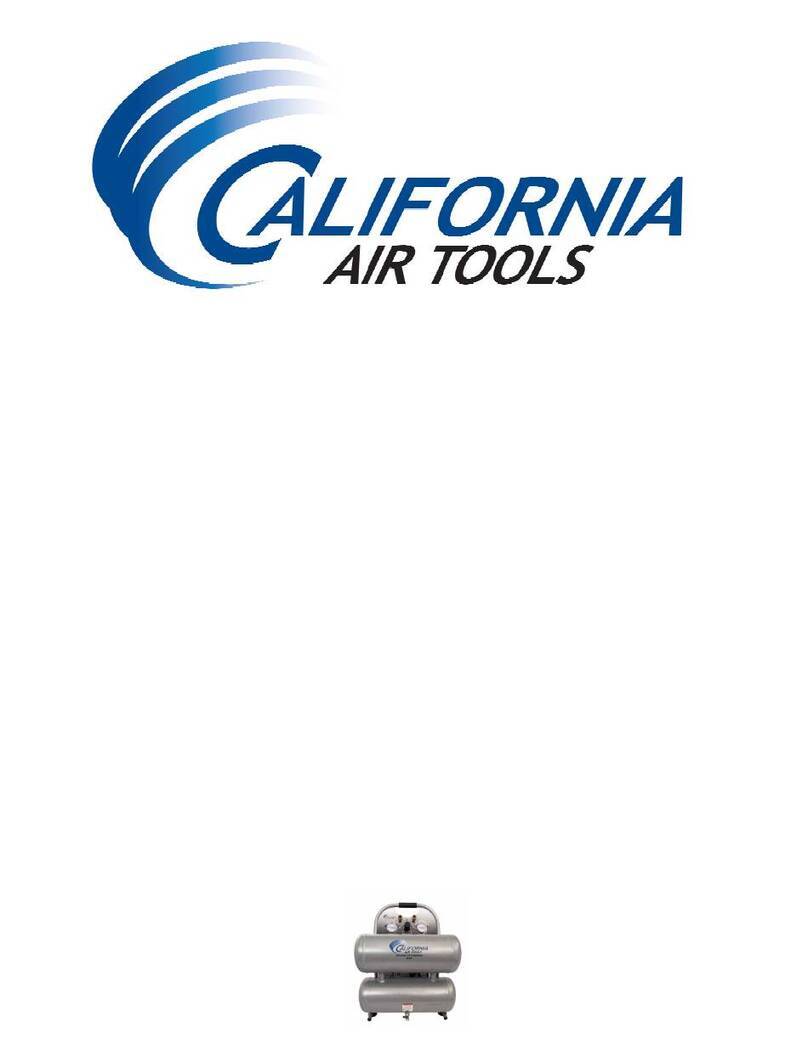
California Air Tools
California Air Tools 4610S owner's manual
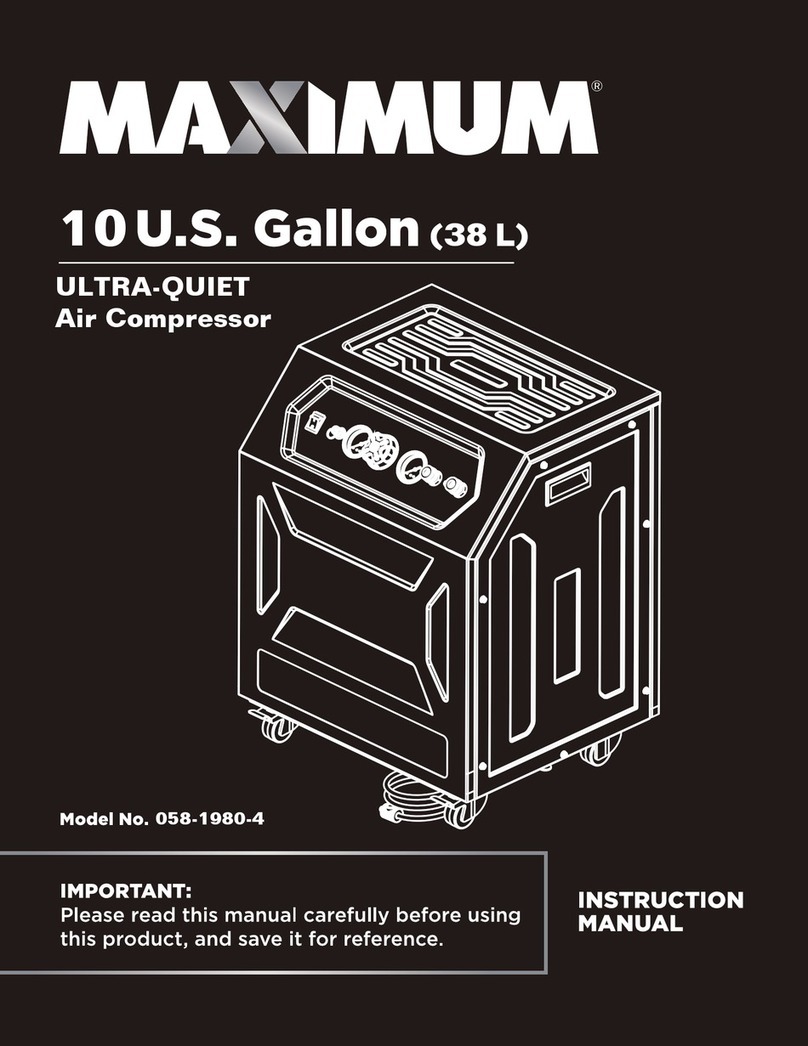
Maximum
Maximum 058-1980-4 instruction manual

Drive Medical
Drive Medical Drive CHAD 50 Patient instructions
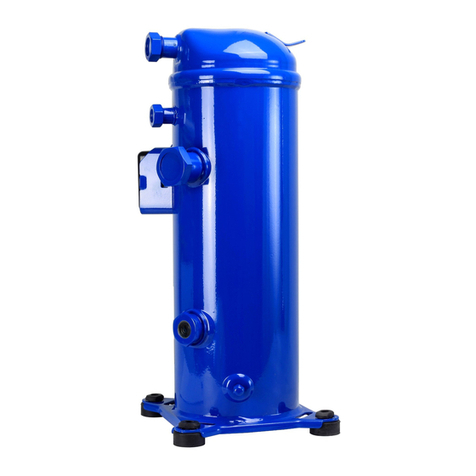
Danfoss
Danfoss LLZ-B instructions
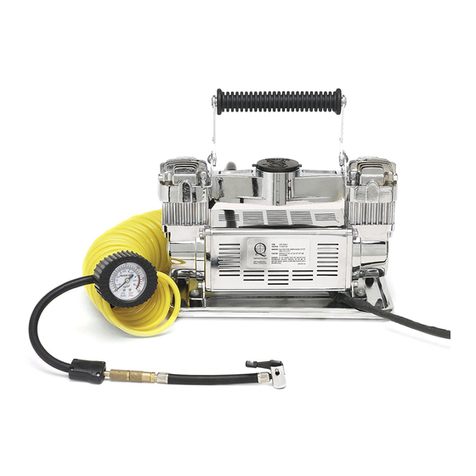
Smittybilt
Smittybilt Q89 installation instructions
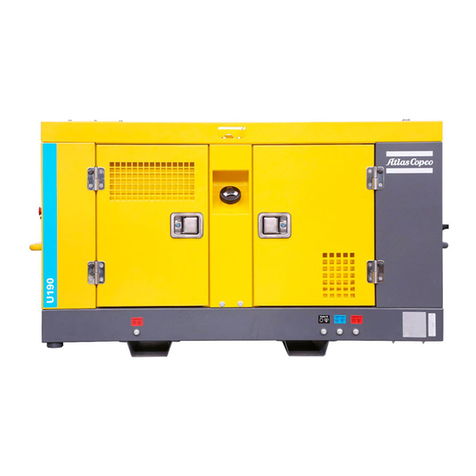
Atlas Copco
Atlas Copco U190 PACE KD WUX installation manual
